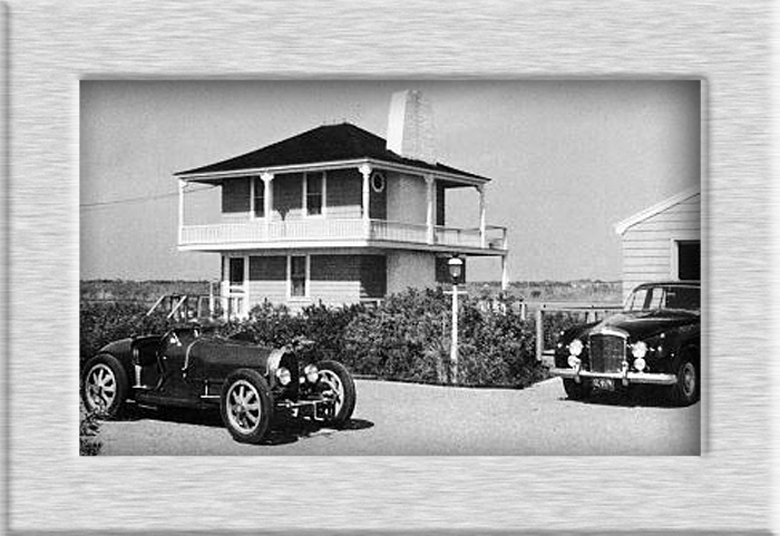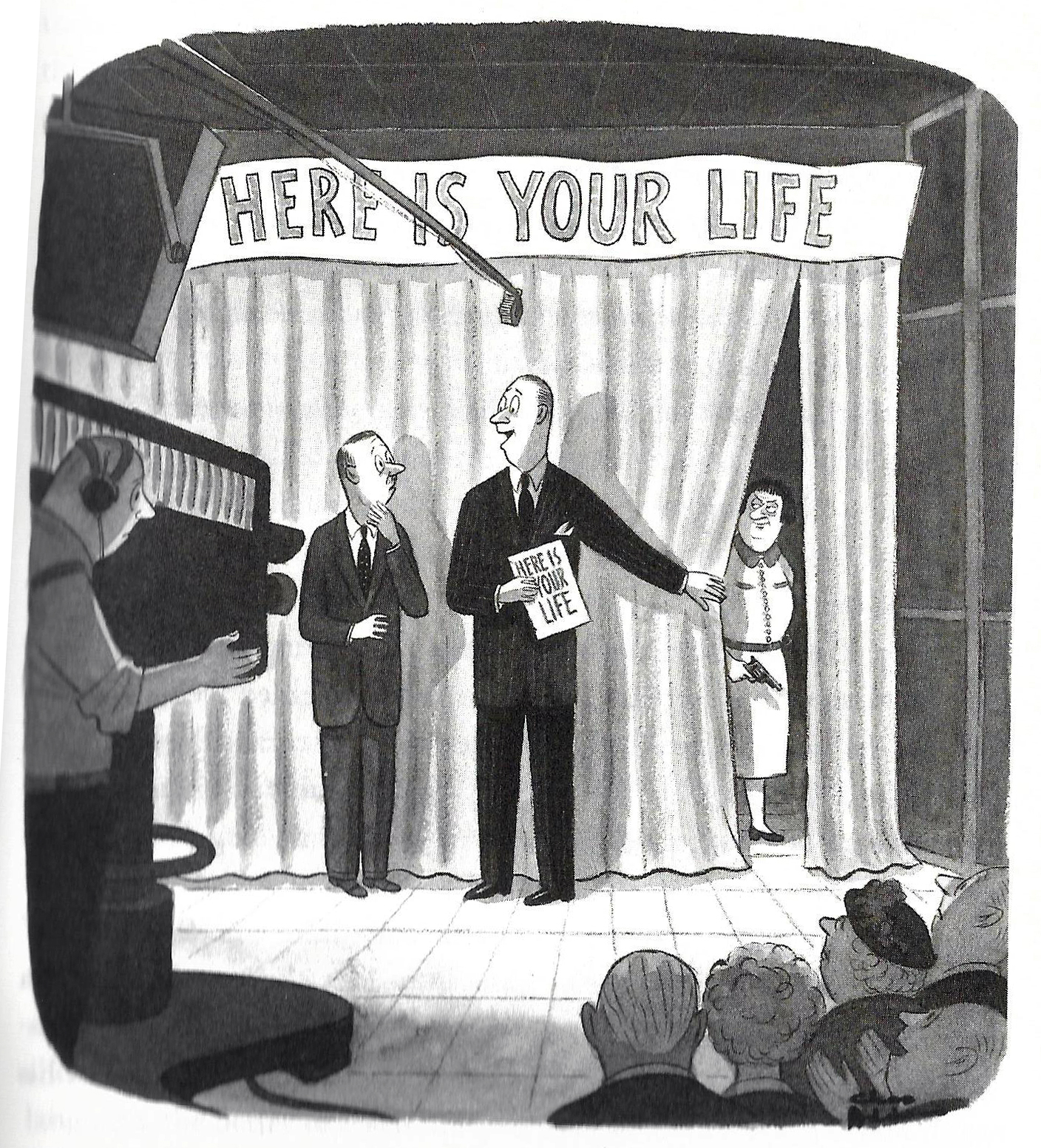Review by Pete Vack
Charles Addams: A Cartoonist’s Life By Linda H. Davis
Turner Publishing Company, Nashville TN First published 2006
ISBN 9781684426898
Pages: 408
Paperback, 10-19-2021
Purchase here
A charmed life, a charming man
Properly executed, a biography covers the entire spectrum of the subject’s work, interests and relationships, allows little to the imagination, leaves no questions in the mind of the reader, and above all, gives the reader feeling that, living or dead, saint or sinner, the subject is as familiar as one’s best friend.
When it comes to writing such a biography, Linda H. Davis, author of Charles Addams, A Cartoonist’s Life, has done a superb job, competently addressing all of the above criteria. What’s more, between the cartoons and love affairs, she deftly includes the Alfas, Bugattis, Amilcars and Astons owned and loved by Addams; Davis gets it, and in full measure. This is not always the case with biographers. When the 688 page life story of Italian director Roberto Rossellini was published in 1998, the biographer made no notice of the director’s passion for cars, racing and his many Ferraris – not even the misnamed “Bergman” Ferrari showcar. But with Davis’ Addams biography, the first appearance of a classic car is on page 7 and his involvement with Bugattis, Alfas, Amilcar, Aston Martins and Audi continues throughout his life and her book.
Though often deemed trite by academics, automobiles – our kind of automobiles – were high on the Addams’ list of priorities. The important things in the life of Charles Addams were his cartoons, his women, and his cars, the cars perhaps on a par with his interest in medieval weaponry and the odd item of torture. He had no children; his life was his art, an awesome East Coast social life, his odd house near Bridgehampton on Long Island, and driving his Bugatti T35C on every possible occasion.

“A floating palace of pleasure” Addams’ beachhouse in Westhampton, NY. Photo from the book, courtesy Tee and Charles Addams Foundation.
His childhood was a bit of a mystery until Davis began her research. “There’s a legend in Westfield, ” recalled Addams in an interview. “They say instead of locking me up in the west wing of the family mansion they gave me a pencil and whipped me until I drew pictures.” But this was typical Addams, feeding expectations. Davis digs in and finds that Addams had a very normal, very happy childhood, nothing to explain his lifelong penchant for the macabre. What was true is that he began drawing as soon as he could hold a crayon. Addams went to the local college, then the University of Pennsylvania, and finally found a home at the Grand Central School of Art. He was just one of the millions of kids who could draw and wanted to be a cartoonist.
Even he realized that a career as a cartoonist probably was not going to happen, so he took a job in the art department of the popular True Detective magazine, until one day in 1932 at the ripe old age of 20, he casually dropped off a cartoon drawing to the New Yorker magazine. It was published, he was paid $7.50 and by 1935 nary a New Yorker failed to have one of his cartoons in the weekly magazine, this at the height of the depression. He never looked back.
Even more luck followed; he was drafted into the Army during WWII, but was quickly transferred to the Signal Corp, billeted in New York and spent the war doing art for movies, articles for the Army, along with other writers and artists such as William Saroyan, Sam Cobean and Stan Lee, later of Marvel Comics. After the war, he was being paid $350 for a New Yorker cover, in addition to his regular cartoons at a time when the average income was $1,223 per year. By 1966, Addams was raking in $21,000 per year for doing what he dearly loved, and most of the time, from home.
His cartoons, most done specifically for the New Yorker magazine, were always odd, offbeat, macabre, puzzling, somewhat gruesome and almost always funny.

“…and now, George Pembrook, here is the wife you haven’t seen for fifteen years.” From the book, published with permission from the Tee and Charles Addams Foundation
Throughout the book, Davis follows the development of the Addams cartoons, such as the characters in the Addams Family (they weren’t even named until the TV series came about). His cartoons weren’t always scary or gruesome, some based on his experiences or feelings at the time. But ideas for cartoons were often hard to come by. Davis explains how ‘gag’ writers associated with the New Yorker magazine often were paid to come up with ideas for cartoons, and the artists translated the gag to an image on paper.
His income now secure, Addams felt ready to settle down, but his first marriage to “Bobby” Jean Day ended in divorce, but primarily because she wanted children and he didn’t. She got her divorce and married John Hersey, hot off his book “Hiroshima.” With the creation of the “Addams Family,” his income and fame grew as a series of TV hits, plays, books, dolls and movies added to his coffers. Only one obstacle got in his way; the divorce from his second wife, Barbara E. Barb, in in 1956.
When asked about this divorce, Addams said “I am so lucky. She doesn’t want any alimony; she doesn’t want any settlement. She just wants the rights to my cartoons.” Until he died, Barbara served as a lawyer and agent, with full control to the rights of the Addams Family and characters. Yet, even then there was a silver lining; Addams worked with her, realizing that due to the high percentages she was getting, she was actually doing more good for Addams than a normal agent.
After his divorce, Addams remained a very happy and active bachelor for an amazing stretch of 24 years, dating movie stars, models, socialites, debutantes and personalities, and tested their devotion and patience by giving them rides in the Bugatti. According to Davis, Addams’ long time friend and beautiful New York socialite Odette Benjamin did not let “the burn she sustained on a Bugatti ride” keep her from the passenger seat. His social milieu was the sophisticated world of the New Yorker, writers, artists and show business personalities, many escorted about town in Addams’ Bentley, including Greta Garbo and Jackie Kennedy. And could anyone ask for a better place to work than at the New Yorker? Addams worked under Harold Ross, William Shawn, and even Robert Gottlieb in the very heyday of one of America’s most influential magazines. Not bad for a kid from Westfield. Finally, he married an old friend, “Tee” Miller, and settled into a very comfortable relationship until his death of a heart attack in 1988.
Unusual for a personality in the arts, Addams seemed to have been widely respected, loved by the women he met, and Linda Davis had a rough time finding anyone who had a bad word for Addams, aside from a neighbor who complained about his Bugatti. “It sounded worse than a jackhammer,” said one. On Sunday mornings, Addams would warm up the Bugatti and the fragrant castor oil fumes would drift next door. After several unanswered phone calls the neighbor would run outside and yell, “You Bastard, Addams!” But by all accounts, he was a charming, delightful person, and had many friends; nothing like the evil artist many believed was behind the Addams Family.
The Davis biography is a complete and fitting look at a fascinating figure who loved his work, his women, his cars and lived life to the full. Highly recommended for all. With full index, acknowledgements, notes, credits and permissions.
Read Charles Addams and his Cars Part 1
Read Charles Addams and his Cars Part 2


What a guy ! I imagine starting up your Bugatti on a Sunday morning in Westhampton would still incite the same response from your neighbor.